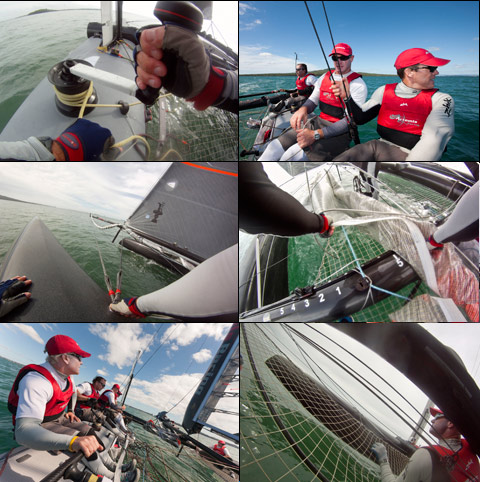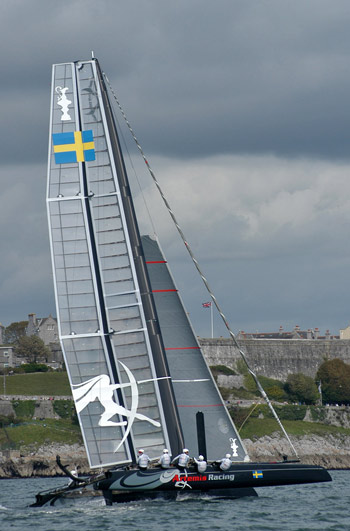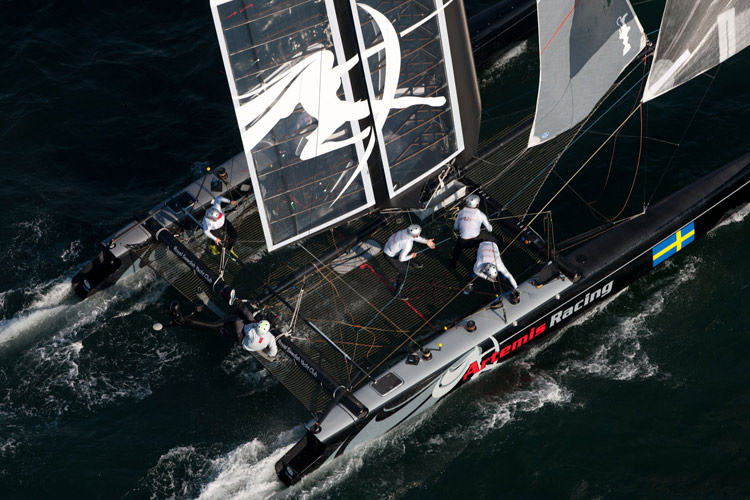|
December 21, 2011 |
||||||||||||||||
You name it, Sean Clarkson has probably sailed it. Clarkson has been hard at it in some of the toughest yacht racing competition in the world: winning the Whitbread on New Zealand Endeavour; sailing as bowman on New Zealand's Soling entry in the 1996 Olympic Games; TP52 World Champion with Quantum Racing; and five America's Cup challenges from 1992 to 2007, with New Zealand, Tag Heuer, AmericaOne, Luna Rossa, and BMW Oracle Racing. So Clarkson knows the America’s Cup, but this America’s Cup? Well, not every so-called “Flintstone” is stuck in Bedrock. Clarkson, a longtime Quantum Racing crew member, emphatically made the transition to multihulls with his TP52 skipper Terry Hutchinson and jib trimmer Morgan Trubovich. After such a lengthy history racing monohulls, moving into the world of multihulls has not been as difficult as one might think -- excepting a few moments onboard the Extreme 40 the team raced last year. “Once you get over the fact that it’s a multihull, it’s just a sailboat,” says Clarkson with a smile. “We went out in an Extreme 40 last year and tried to do everything differently because we were in a multihull and got all chicken-winged up. I think we made it harder on ourselves, actually. It’s really not that difficult, we just tried to over-analyze everything. As soon as we appreciated that it’s just a sailboat -- you go out there, have a good start, get the shifts and have good crew work -- it all goes well. The smoother you sail it, the better shifts you get, the better starts you have, you still win races. There’s no mystery to it, so that’s the biggest thing.
“You’re starting to see the top keelboat sailors quickly becoming the top multihull sailors and actually surpassing all the legendary Olympians. If you’re a good team and you have good sailors, you’ll do pretty well. You don’t have to have a huge background in multihulls -- it’s just a sailboat.” That the 41-year-old Clarkson has deftly made the transition to multihulls is in part due to a rigorous fitness regimen. As Iain Murray, America's Cup Regatta Director, noted recently, one of the fitter sailors was measured with a pulse of 197 beats-per-minute three times in the course of one 20-minute race last month in Plymouth. These cats are demanding. “The big thing that’s harder in the AC45s is the physical aspect of it. It’s so physical. It’s very hard to have finesse and make smooth decisions and make smart decisions when you’re absolutely exhausted. All the work onboard is done at a very high level, you’ve got to get pretty aggressive to get stuff done." "You have to be able to quickly step back to sailing smart. So that’s the hard thing -- and communicating when you’re out of breath and balancing sailing well versus the crew work. It takes a bit of time, especially as a core crew. You’ve got to sail together for a while to get that. We’re getting there! “It’s different, but we’ve all sailed together a lot and we’ve all sailed five-man match racing boats and three-man or two-man Olympic boats. So we’re all used to that sort of dynamic, of taking more or less on. The difference here from previous America’s Cup is going from sailing with 17 crew to sailing with five. It’s just the whole dynamic of five people versus 17 people and their roles on board -- the communication, things like that. But when we get to the AC72, we’re back to 11 crew on board, so there will be another iteration of the dynamics. “But this Cup brings out a slightly different breed of sailor. You don’t see many of the big, burly grinders out here, you see more athletic guys. Mid-range guys -- smart, athletic guys. There’s no place for someone who’s not a very good sailor. From the bowman back, we all have to be very tactical and intelligent as well as strong and fit. It’s a new breed. It’s supposed to be the Facebook generation, right? But I think us old guys are still going pretty well!”
Another obvious difference going from the old America's Cup Class to the new AC45 is the hard wing. Clarkson, like the other wing trimmers, has quickly assimilated many nuances of the AC45, though of course the wings on the AC72 will be another animal entirely. “The trimming aspect is probably easier on an AC45 wing because they are very, very basic wings. There’s not a lot you can actually change while you are racing, so there aren’t many controls. The trimming aspect is more about the balance of the boat and anticipating the breeze. With the catamaran, the lower you can fly your hull, the more stability you get. It’s the opposite of a keelboat, where the more heel you get, the more righting moment you gain. So it’s all about the perfect balance between the jib and the wing, with the hull just skimming the water. It’s anticipating shifts, pressure, things like that. And on top of that, trying to help out with the big picture -- calling what you see, pressure-wise. It’s not really different than sailing any other boat, it’s just more physical.” Much of the set-up on the wing is done on shore, particularly after an extensive look at the weather forecast. Despite the fact that it’s such a space-age looking device, the wing really does react very similarly to a soft sail. Or at least similarly enough for Clarkson's purpose. “Once you get racing, you’re basically just playing the camber, more upwind-downwind, and the twist control, which controls the relative twist between the three wing elements. That’s one fine-tune that we do play with. Otherwise, it’s just playing the traveler to make sure you’re in synch with the jib. And we have the wing sheet on the clew of the wing which adjusts the power of the wing, the throttle, so you can power up very quickly.” “The one good thing about multihulls is they’re very good at telling you when you’re out of whack. A keelboat, if you’re going badly, you might be 0.2 knots slower and you’re thinking ‘that just doesn’t feel right’, but in a multihull you’d be two knots slower if something’s wrong, and the boat will feel squirrelly. It’s very good at telling you that there’s something out of whack. So there’s a premium on getting it right, because obviously there’s a big differential on gains and losses. You see two boats out there and one just goes straight past the other one and you think, ‘what’s wrong?’ It’s not much -- it’s in the setting up, in the communication between the jib trimmer and the helmsman, getting the balance right.” Even as the teams become used to the AC45, the AC72 looms large in their collective futures. Designers around the world are hammering out the new models, and the build teams are getting busy with components being delivered in anticipation of July 2012 launches. Artemis is building their hulls in Orust, Sweden, to be joined in Valencia with the wing and other major portions being built in Spain and elsewhere. Clarkson and his mates are working closely with the Artemis designers as they take input from the sailing team and apply what works to the new boats. “We’re learning a lot, because the science of it is exciting and intriguing. But as trimmers, we have to learn what we’re getting so we can get the best out of it. I live in Valencia and our design team is there, so I can have daily contact with them and they can bring me up to speed -- we can have discussions about how it’s going to be controlled and how complicated or simple to make systems versus gains and losses and the intensity of the racing we’re going to have. It’s going to be interesting.” --Diane Swintal for CupInfo/©2011 CupInfo.com Sean Clarkson Sailing Background: America's Cup
Experience: Other Notable
Achievements Include:
|
||||||||||||||||
|
Additional Links and Info:
Visit Artemis Racing at Official America's Cup website |



